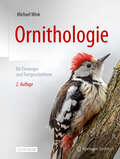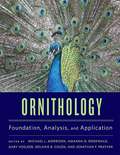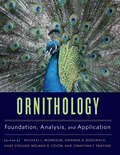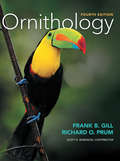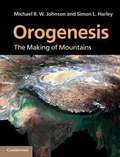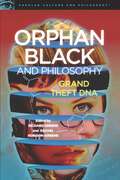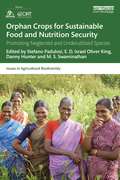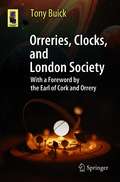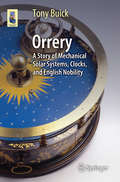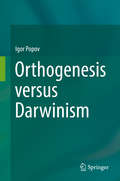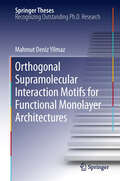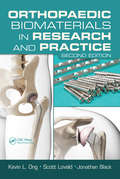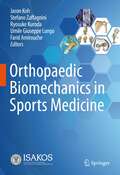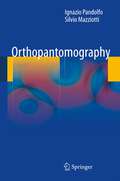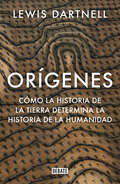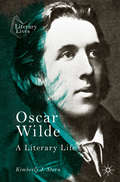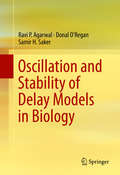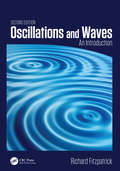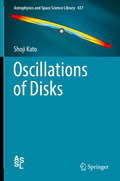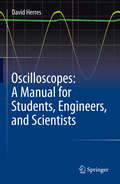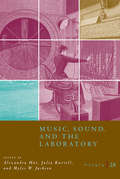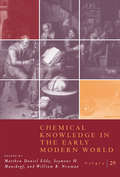- Table View
- List View
Ornamental Livebearers
by B. Ahilan A. KamaliiThis textbook on Ornamental Livebearers is a comprehensive guide and deals with the culture and breeding of livebearers. The present status of ornamental fish farming and new technologies on the breeding and culture of livebearers have also been aptly dealt with. A wide range of aspects such as, anatomy of livebearers, important livebearers and their breeding, feed and feeding management, water quality management, disease management biosecurity and economics of livebearers fish farm have been described in detail. It is hoped that this publication presented in an easy-to-read style with a number of photographs and illustrations will be of great use to all students who have fisheries in their curriculum and also a standard guide for the researchers, entrepreneurs and ornamental fish farmers.
Ornithologie für Einsteiger und Fortgeschrittene
by Michael WinkDieses Buch widmet sich den faszinierenden Aspekten der Vogelbiologie. Der erste Teil liefert allgemeine Informationen und gibt Hilfestellungen für all jene, die in das Hobby „Vogelbeobachtung“ einsteigen möchten. Für den erfahrenen Vogelbeobachter liefert der zweite Teil des Buches die Grundlagen der wissenschaftlichen Ornithologie. Evolution und Systematik der Vögel, Anatomie und Physiologie, Ernährung, Entwicklung, Verhalten, Zug und Orientierung, Bestandsveränderungen, Neozoen, Gefahren durch Fressfeinde und Krankheiten sowie Vogelschutz werden kurz und prägnant dargestellt. Der Leser lernt die verschiedenen Methoden und Hilfsmittel der Vogelforschung kennen. Eine Vielzahl exzellenter Fotos vieler europäischer Vogelarten und anschauliche Grafiken verleihen diesem Buch einen besonderen Reiz Diese überarbeitete Neuauflage im vergrößerten Format enthält viele neue Fotographien. Sie wurde inhaltlich aktualisiert und mit zahlreichen Links zu interessanten Internetseiten ausgestattet.
Ornithology: Foundation, Analysis, And Application
by Michael Morrison Gary Voelker Jonathan Prather Amanda Rodewald Melanie ColónAves, the birds, is the wildlife group that people most frequently encounter. With over 10,000 species worldwide, these animals are part of our everyday experience. They are also the focus of intense research, and their management and conservation is a subject of considerable effort throughout the world. But what are the defining attributes that make a bird a bird? Aimed at undergraduate and graduate students, Ornithology provides a solid modern foundation for understanding the life and development of birds. Written by renowned experts from around the globe, this comprehensive textbook draws on the latest research to create an innovative learning experience. Moving beyond bones, muscle, and feathers, it provides the core information needed to "build" the bird, linking anatomy and physiology with ecology and behavior. As it reviews the major orders of birds, the book highlights their wide diversity and critically evaluates ornithological concepts and theories. Incorporating brief biographies of leaders in the field, the text describes their contributions in the context of key historical events in bird science. Each chapter ends with a summary of the material covered, a discussion of potential management and conservation applications, and suggested study questions that will stimulate thought and discussion.
Ornithology: Foundation, Analysis, and Application
by Michael L. Morrison, Amanda D. Rodewald, Gary Voelker, Melanie R. Colón, Jonathan F. PratherThe essential text for ornithology courses, this book will leave students with a lifelong understanding and appreciation of the biology and ecology of birds.Aves, the birds, is the wildlife group that people most frequently encounter. With over 10,000 species worldwide, these animals are part of our everyday experience. They are also the focus of intense research, and their management and conservation is a subject of considerable effort throughout the world. But what are the defining attributes that make a bird a bird?Aimed at undergraduate and graduate students, Ornithology provides a solid modern foundation for understanding the life and development of birds. Written by renowned experts from around the globe, this comprehensive textbook draws on the latest research to create an innovative learning experience. Moving beyond bones, muscle, and feathers, it provides the core information needed to "build" the bird, linking anatomy and physiology with ecology and behavior.As it reviews the major orders of birds, the book highlights their wide diversity and critically evaluates ornithological concepts and theories. Incorporating brief biographies of leaders in the field, the text describes their contributions in the context of key historical events in bird science. Each chapter ends with a summary of the material covered, a discussion of potential management and conservation applications, and suggested study questions that will stimulate thought and discussion. Contributors: Peter Arcese, George E. Bentley, Lori A. Blanc, William M. Block, Alice Boyle, Leonard A. Brennan, Luke K. Butler, Zac Cheviron, Luis M. Chiappe, Melanie R. Colón, Caren B. Cooper, Robert J. Cooper, Jamie M. Cornelius, Carlos Martinez Del Rio, John Dumbacher, Shannon Farrell, Maureen Flannery, Geoffrey Geupel, Patricia Adair Gowaty, Thomas P. Hahn, Ashley M. Heers, Fritz Hertel, Geoffrey E. Hill, Matthew Johnson, Lukas F. Keller, Dylan C. Kesler, Pablo Sabat Kirkwood, John Klicka, Christopher A. Lepczyk, Ashley M. Long, Scott R. Loss, Graham R. Martin, John M. Marzluff, Susan B. McRae, Michael L. Morrison, Timothy J. O’Connell, Jen C. Owen, Marco Pavia, Jeffrey Podos, Lars Pomara, Jonathan F. Prather, Marco Restani, Alejandro Rico-Guevara, Amanda D. Rodewald, Vanya G. Rohwer, Matthias Starck, Michael W. Strohbach, S. Mažeika P. Sullivan, Diego Sustaita, Kerri T. Vierling, Gary Voelker, Margaret A. Voss, Jeff R. Walters, Paige S. Warren, Elisabeth B. Webb, Michael S. Webster, Eric M. Wood, Robert M. Zink, Benjamin Zuckerberg
Ornithology: Michelangelo, Florence, And The David 1492-1504
by Richard Prum Frank GillOrnithology, 4th Edition is a comprehensive introductory text covering a wide scope of topics essential for understanding the field of ornithology. This new edition infuses the most current research and a more conceptual approach alongside an evolutionary perspective. The 4th edition retains its hallmark readability, as well as a well updated narrative and bibliography with the latest scientific content and references. The 4th edition will be the first in full color in both art and design and will include over 400 color photographs. The updated design is clean, colorful, approachable, and easy to use as a narrative or study reference. New pedagogical elements reinforce key concepts new end of chapter assessment questions allow students to evaluate their learning. The 4th edition is the best yet, during both a student’s first read, and when revisited as a reference.
Orogenesis: The Making of Mountains
by Michael R. Johnson Simon L. HarleyOrogenesis, the process of mountain building, occurs when two tectonic plates collide - either forcing material upwards to form mountain belts such as the Alps or Himalayas or causing one plate to be subducted below the other, resulting in volcanic mountain chains such as the Andes. Integrating the approaches of structural geology and metamorphism, this book provides an up-to-date overview of orogenic research and an introduction to the physico-chemical properties of mountain belts. Global examples are explored, the interactioning roles of temperature and deformation in the orogenic process are reviewed, and important new concepts such as channel flow are explained. This book provides a valuable introduction to this fast-moving field for advanced undergraduate and graduate students of structural geology, plate tectonics and geodynamics, and will also provide a vital overview of research for academics and researchers working in related fields including petrology geochemistry and sedimentology.
Orphan Black and Philosophy
by Richard Greene Rachel Robison-GreeneIn Orphan Black, several apparently unconnected women discover that they are exact physical doubles, that there are more of them out there, that they are all illegally produced clones, and that someone is having them killed. They find themselves in the midst of a secret and violent struggle between a fundamentalist religious group, a fanatical cult of superhuman biological enhancement, a clandestine department of the military, and a giant biotech corporation. Law enforcement is powerless and easily manipulated by these sinister forces. The clones are forced to form their own Clone Club, led by the resourceful Sarah Manning, to defend themselves against their numerous enemies and to find out exactly where they came from and why. <p><p> Orphan Black continually raises philosophical issues, as well as ethical and policy questions deserving philosophical analysis. What makes a person a unique individual? Why is it so important for us to know where we came from? Should we have a say in whether a clone is made of us? Is it immoral to generate clones with built-in health problems or personality defects - and if so, does that mean that producers of clones must practice eugenic selection? What light does the behavior of members of the Clone Club shed on the nature-nurture debate? Is it relevant that most are heterosexual, one is a lesbian, and one is a transgender male? <p> This TV show shows us problems of biotechnology which will soon be vital everyday issues. But what kind of a future faces us when human clones are commonplace? Will groups of human clones have a tight bond of solidarity making them a threat to democracy? If the world is going to be taken over by an evil conspiracy, would it better be a scientific cult like Neolution or a religious cult like the Prolethians? Should biotech corporations be able to own the copyright on human DNA sequences? What rules of morality apply when you can't trust the police and powerful groups are ready to murder you?
Orphan Crops for Sustainable Food and Nutrition Security: Promoting Neglected and Underutilized Species (Issues in Agricultural Biodiversity)
by Danny Hunter Stefano Padulosi E.D. Israel Oliver King M. S. SwaminathanOrphan Crops for Sustainable Food and Nutrition Security discusses the issues, challenges, needs and opportunities related to the promotion of orphan crops, known also as neglected and underutilized species (NUS). The book is structured into six parts, covering the following themes: introduction to NUS, approaches, methods and tools for the use enhancement of NUS, integrated conservation and use of minor millets, nutritional and food security roles of minor millets, stakeholders and global champions, and, building an enabling environment. Presenting a number of case studies at the regional and country levels, the chapters cover different but highly interlinked aspects along the value chains, from acquisition and characterization of genetic diversity, cultivation and harvesting to value addition, marketing, consumption and policy for mainstreaming. Cross-cutting issues like gender, capacity building and empowerment of vulnerable groups are also addressed by authors. Representatives from communities, research for development agencies and the private sector also share their reflections on the needs for the use enhancement of NUS from their own perspectives. This book will be of great interest to students and scholars of food security, sustainable agriculture, nutrition and health and development, as well as practitioners and policymakers involved in building more resilient food and production systems.
Orreries, Clocks, and London Society: The Evolution of Astronomical Instruments and Their Makers (Astronomers' Universe)
by Tony BuickOrreries—mechanical models of the Solar System and its motions—are found everywhere. They appear in paintings, on computers, across natural landscapes, and in museums all over the world. The more you look, the more you find, yet their significance is often overlooked aside other great astronomical inventions.This book reclaims the history of the orrery, offering a fascinating look into its evolution over the centuries. With a particular focus on London society and clockmakers, it weaves together historical narrative with practical know-hows and scientific fact, showing how the orrery changed from a fanciful toy to a high-tech instrument to a vessel for art and education. The first edition, Orrery, explained what an orrery is and how it got its name. This revised edition goes several steps further, tracing the instrument back to the time of Ptolemy and forward to planetariums and star projectors. In addition, it features new sections on how to construct your own orrery at home.This book will appeal to anybody interested in astronomical mechanical devices, scientific instruments, horology, or the history of clocks.
Orrery
by Tony Buick"Orrery" appeals to almost anyone interested in popular astronomy, astronomical mechanical devices, scientific instruments, the history of clocks - and even the history of aristocratic and prestigious families! Many people these days - not only astronomers - have a good idea of the main components of the Solar System. They might also know about the orrery, a mechanical model that shows the movements of the Moon and planets. But not too many know why it was so named and who it was named after. The Boyle family - the Earls of Orrery -include the famous Boyle of Boyle's Law. But others were key in the history of the orrery, not the least being clockmakers. Aware of the lunar and planetary content of the sky, they strove to make scientific instruments to demonstrate their movements and introduced measuring devices to predict their positions. In antiquity, their lives on occasion depended on the accuracy; upsetting kings and lords was dangerous business! Orreries are found everywhere. They can be made of wood or metal, and are even available today as home-assembly kits and children's toys. They appear in paintings, on computers, on the side of royal clocks, in stately home hallways, and of course, in museums all over the world. This book contains illustrations of orreries to give a guide as to what is and was available and where to see the best examples. It also contains information and references to help readers who want to make (or buy) their own orrery. The story of the Boyles is not just relevant to a tiny corner of Ireland, but spans the world. "Orrery" highlights the process of discovery and humankind's universal fascination with the heavens. Provides a fascinating example of the relationship between innovative thinking (invention) and precision engineering (execution).
Orthobiologics: Injectable Therapies for the Musculoskeletal System
by Norimasa Nakamura Bert R. Mandelbaum Giuseppe Filardo George F. Muschler Scott A. RodeoThis book presents the evidence related to the use of injectable biologics to provide faster and better healing for musculoskeletal lesions and conditions. The authors discuss approaches, such as blood derivatives and cell concentrates, applied to lesions of muscles, ligaments, tendons, bones, meniscus and cartilage, as well as osteoarthritis. Chapters are written by some of the most influential opinion leaders in the field, with up-to-date review of the current literature, where the authors explore both the potential and the limitations of these minimally invasive and promising treatments.The first section is devoted to the formulations and rationale for the use of injectable orthobiologics, while the second section reviews current treatment methods applied to specific joints and pathologies – ranging from tendinopathies through non-unions to articular degenerative processes – as well as the results of these treatment approaches. The third section explores future perspectives, such as pluripotent stem cells, gene therapy, and the stimulation of intrinsic stromal cell niches. Appealing to a broad readership, this book will be of interest to both laboratory research scientists and clinicians, including orthopedists, sports physicians, physiatrists, and regenerative medicine experts.
Orthogenesis versus Darwinism
by Igor PopovThis book reviews the convoluted history of orthogenesis with an emphasis of non-English sources, untangles relationships between various concepts of directed evolution and argues whether orthogenesis has something to offer modern biology. Darwinism claims that evolution occurs by selection from an extensive random variability. An alternative viewpoint—that the material for variability is limited and organisms are predisposed to vary in certain directions—is the essence of evolutionary concepts that can be grouped together under the name of orthogenesis. Dating back to Lamarck, orthogenesis has existed in many guises. Branded as mystical and discarded as unscientific, it keeps re-emerging in evolutionary discussions.
Orthogonal Supramolecular Interaction Motifs for Functional Monolayer Architectures
by Mahmut Deniz YilmazDeniz Yilmaz' thesis describes a combination of orthogonal supramolecular interactions for the design of functional monolayer architectures on surfaces, that can be used as chemical and biosensors in a wide range of applications. The term "orthogonal supramolecular interactions" refers to non-covalent interactions that do not influence each other's assembly properties. Orthogonal self-assembly thus allows extended control over the self-assembly process and promotes new materials properties. The first part of the thesis employs orthogonal host-guest and lanthanide-ligand coordination interaction motifs to create supramolecular luminescent monolayers. The second part of the thesis describes the fabrication of functional monolayers on silicon and gold substrates for applications in electronics. The results illustrate the power of weak supramolecular interactions to direct the immobilization of functional systems on surfaces. The combination of host-guest and lanthanide-ligand coordination interaction motifs on surfaces demonstrates that hybrid, multifunctional supramolecular monolayers can be fabricated by integrating different non-covalent interactions in the same system. This combination opens up new avenues for the fabrication of complex hybrid organic-inorganic materials and stimuli-responsive surfaces. Their utility is demonstrated through applications of the functional interfaces to biosensing and nanotechnology.
Orthopaedic Biomaterials in Research and Practice
by Jonathan Black Kevin L. Ong Scott LovaldRevised, expanded, and updated, Orthopaedic Biomaterials in Research and Practice, Second Edition introduces materials science and applies it to medical research and treatment. This book incorporates math and engineering, which makes it accessible to trainees and others working in the industry who are lacking primary mathematical and engineering tr
Orthopaedic Biomechanics
by Beth A. WinkelsteinGiven the strong current attention of orthopaedic, biomechanical, and biomedical engineering research on translational capabilities for the diagnosis, prevention, and treatment of clinical disease states, the need for reviews of the state-of-art and current needs in orthopaedics is very timely. Orthopaedic Biomechanics provides an in-depth review o
Orthopaedic Biomechanics in Sports Medicine
by Stefano Zaffagnini Ryosuke Kuroda Umile Giuseppe Longo Farid Amirouche Jason KohThis book presents a fundamental basic overview of orthopedic biomechanics in sports medicine, with a special focus on the current methodologies used in modeling human joints, ligaments, and muscle forces. The first part discusses the principles and materials, including the use of finite element analysis (FEA) to analyze the stress-strain response in the implant-bone interface and design. The second part focuses on joint-specific biomechanics, highlighting the biomechanics of the knee and shoulder joints, their modeling, surgical techniques, and the clinical assessment of joint performance under various kinematic conditions resulting from different repair techniques. Written by international experts working at the cutting edge of their fields, this book is an easy-to-read guide to the fundamentals of biomechanics. It also offers a source of reference for readers wanting to explore new research topics, and is a valuable tool for orthopedic surgeons, residents, and medical students with an interest in orthopedic biomechanics.
Orthopantomography
by Silvio Mazziotti Ignazio PandolfoAlthough orthopantomography (OPT) is a very frequently employed radiological examination, even the expert radiologist can encounter difficulty in reporting the findings owing to the specific terminology, the nature of the diagnostic queries, and the need to describe precisely the clinical implications for the dentist. Additionally, artifacts are a frequent occurrence, and many radiologists and dentists are unfamiliar with their causes and solutions. Methodological inaccuracies during the execution of OPTs also have important clinical implications. For all of these reasons, this richly illustrated monograph on OPT sets out to describe in detail diverse technical and methodological aspects of the examination, from image acquisition through to artifact generation due to lack of experience or malfunctioning. Possible solutions are suggested for all of the most common diagnostic and methodological problems. Emphasis is placed on appropriate terminology and guidance offered on the interpretation of findings in a range of conditions, including the most common odontological problems. This book will be of great value to the radiologist in routine interpretation and reporting of OPTs.
Orígenes: Cómo la historia de la Tierra determina la historia de la humanidad
by Lewis Dartnell¿Por qué? ¿Pero por qué? ¿Y por qué? La historia humana como nunca antes te la habían contado. Cuando se habla de algo tan inabarcable como la historia de la humanidad solemos poner el foco en cosas muy concretas. Nos gusta enumerar los líderes que marcaron la diferencia, señalar ciertos fenómenos como la migración o describir las consecuencias de las guerras más decisivas. Pero, ¿qué pasaría si cambiáramos el enfoque y pusiéramos a la Tierra en el centro de nuestras averiguaciones? Este libro es lo que pasaría. Para Lewis Dartnell la única manera de comprender nuestra historia consiste en explicar cómo nuestro planeta, desde el inicio de los tiempos, ha determinado nuestro destino. Toda especie está condicionada por su entorno. Es algo ineludible: las fuerzas geológicas ocasionaron nuestra evolución en África oriental; los terrenos montañosos característicos de Grecia favorecieron el nacimiento de la democracia en las antiguas polis, y el Himalaya guarda una relación con la formación de las islas Británicas que muchos ignoramos. La historia de estas fuerzas es, en definitiva, la historia de la humanidad. Reseñas:«Orígenes es uno de esos escasos libros que saben resolver los misterios con el simple y sublime uso de la lucidez. Dartnell entiende de geología, geografía, antropología, física, química, biología, astronomía e historia; un logro en sí mismo. Pero lo que le hace realmente especial es la forma en la que enlaza estas disciplinas de manera clara, lógica y entretenida. [...] Un libro excelente.»The Times «Una historia sublime y bien encadenada. La curiosidad y entusiasmo de Dartnell son contagiosos y arrastran al lector de una página a otra, sintetizando geología, oceanografía, meteorología, geografía, paleontología, arqueología e historia política de una manera que recuerda al clásico libro de Jared Diamond Armas, gérmenes y acero.»Nature «Dartnell es un excelente guía para recorrer los desalentadores eones de nuestro tiempo. Nunca la historia geológica ha parecido tan necesaria.»The Guardian «Una tesis grandiosa y apasionante impulsada por el placer que producen los pequeños detalles. Esta sensacional visión de cómo la geografía nos dio forma puede tranquilamente compararse con el Sapiens de Harari.»The Sunday Times
Oscar Wilde: A Literary Life (Literary Lives)
by Kimberly J. SternOscar Wilde: A Literary Life tracks the intellectual biography of one of the most influential minds of the nineteenth century. Rather than focusing on the dramatic events of Wilde’s life, this volume documents Wilde’s impressive forays into education, religion, science, philosophy, and social reform. In so doing, it provides an accessible and yet detailed account that reflects Wilde’s own commitment to the “contemplative life.” Suitable for seasoned readers as well as those new to the study of his work, Oscar Wilde: A Literary Life brings Wilde’s intellectual investments into sharp focus, while placing him within a cultural landscape that was always evolving and often fraught with contradiction.
Oscillation and Stability of Delay Models in Biology
by Ravi P. Agarwal Donal O'Regan Samir H. SakerEnvironmental variation plays an important role in many biological and ecological dynamical systems. This monograph focuses on the study of oscillation and the stability of delay models occurring in biology. The book presents recent research results on the qualitative behavior of mathematical models under different physical and environmental conditions, covering dynamics including the distribution and consumption of food. Researchers in the fields of mathematical modeling, mathematical biology, and population dynamics will be particularly interested in this material.
Oscillations and Waves: An Introduction, Second Edition
by Richard FitzpatrickEmphasizing physics over mathematics, this popular, classroom-tested text helps advanced undergraduates acquire a sound physical understanding of wave phenomena. This second edition of Oscillations and Waves: An Introduction contains new widgets, animations in Python, and exercises, as well as updated chapter content throughout; continuing to ease the difficult transition for students between lower-division courses that mostly encompass algebraic equations and upper-division courses that rely on differential equations. Assuming familiarity with the laws of physics and college-level mathematics, the author covers aspects of optics that crucially depend on the wave-like nature of light, such as wave optics. Examples explore discrete mechanical, optical, and quantum mechanical systems; continuous gases, fluids, and elastic solids; electronic circuits; and electromagnetic waves. The text also introduces the conventional complex representation of oscillations and waves during the discussion of quantum mechanical waves. Features: Fully updated throughout and featuring new widgets, animations, and end of chapter exercises to enhance understanding Provides a clear, concise, systematic, and comprehensive treatment of the subject matter that emphasises physics over mathematics Offers complete coverage of advanced topics in waves, such as electromagnetic wave propagation through the ionosphere Includes examples from mechanical systems, elastic solids, electronic circuits, optical systems, and other areas
Oscillations of Disks
by Shoji KatoThis book presents the current state of research on disk oscillation theory, focusing on relativistic disks and tidally deformed disks. Since the launch of the Rossi X-ray Timing Explorer (RXTE) in 1996, many high-frequency quasiperiodic oscillations (HFQPOs) have been observed in X-ray binaries. Subsequently, similar quasi-periodic oscillations have been found in such relativistic objects as microquasars, ultra-luminous X-ray sources, and galactic nuclei. One of the most promising explanations of their origin is based on oscillations in relativistic disks, and a new field called discoseismology is currently developing. After reviewing observational aspects, the book presents the basic characteristics of disk oscillations, especially focusing on those in relativistic disks. Relativistic disks are essentially different from Newtonian disks in terms of several basic characteristics of their disk oscillations, including the radial distributions of epicyclic frequencies. In order to understand the basic processes of disk oscillations, studies on binary systems are of importance, as they offer valuable information on wave-wave coupling processes in disk oscillations. Accordingly, some characteristics of oscillations in deformed disks are also presented in this book. The book consists of two parts. Points covered in Part I include, for instance, the basic characteristics of disk oscillations, classification of oscillation modes, and trapping of oscillations. In Part II, the focus is mainly on excitation processes of oscillations, while applications to observations are also discussed.
Oscilloscopes: A Manual for Students, Engineers, and Scientists
by David HerresThis text presents readers with an engaging while rigorous manual on the use of oscilloscopes in laboratory and field settings. It describes procedures for measuring and displaying waveforms, gives examples of how this information can be used for repairing malfunctioning equipment and developing new designs, and explains steps for debugging pre-production prototypes. The book begins by examining how the oscilloscope displays electrical energy as traces on X and Y co-ordinates, freely transitioning without loss of information between time and frequency domains, in accordance with the Fourier Transform and its modern correlate, the Fast Fourier Transform. The book continues with practical applications and case studies, describes how oscilloscopes are used in diagnosing pulse width modulation (PWM) problems--looking at serial data streaming and analyzing power supply noise and premises power quality issues—and emphasizes the great functionality of mixed-signal as opposed to mixed-domain oscilloscope, and earlier instruments. Featuring many descriptions of applications in applied science and physics, Oscilloscopes: A Manual for Students, Engineers, and Scientists is ideal for students, faculty, and practitioners.
Osiris, Volume 28: Music, Sound, and the Laboratory from 1750-1980 (Osiris #28)
by The University of Chicago PressThe understanding of sound underwent profound changes with the advent of laboratory science in the nineteenth and twentieth centuries. New techniques of sound visualization and detection, the use of electricity to generate sound, and the emergence of computers radically reshaped the science of acoustics and the practice of music. The essays in this volume of Osiris explore the manifold transformations of sound ranging from soundproof rooms to psychoacoustics of seismology to galvanic music to pedaling technique. They also discuss more general themes such as the nature of scientific evidence and the development of instruments and instrumentation. In examining the reciprocity between music and science, this volume reaches a new register in the evolution of scientific methodology during the nineteenth and twentieth centuries.
Osiris, Volume 29: Chemical Knowledge in the Early Modern World (Osiris #29)
by The University of Chicago PressThe last twenty-five years have witnessed some provocative transmutations in our understanding of early modern chemistry. The alchemist, once marginalized as a quack, now joins the apothecary, miner, humanist, and natural historian as a practitioner of “chymistry.” In a similar vein, the Chemical Revolution of the eighteenth century, with its focus on phlogiston and airs, has been expanded to include artisanal, medical, and industrial practices. This collection of essays builds on these reappraisals and excavates the affinities between alchemy, chymistry, and chemistry from the sixteenth to the eighteenth centuries. It reveals a rich world of theory and practice in which instruments, institutions, inscriptions and ideas were used to make material knowledge. More generally, the volume will catalyze wide-ranging discussions of material and visual cultures, the role of expertise, and the religious and practical contexts of scientific inquiry.

